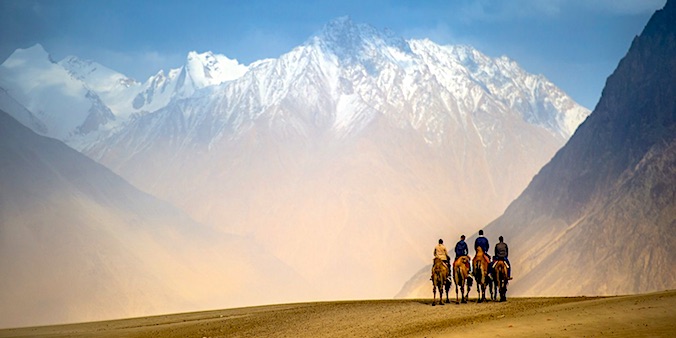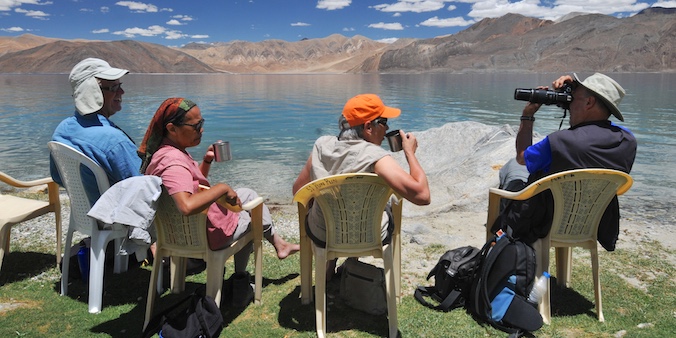LADAKH OVERLAND via ZANSKAR
Tour - 17 days
LADAKH OVERLAND via ZANSKAR
Tour - 17 days
About LADAKH & KASHMIR
Ladakh and Kashmir are part of the Indian Himalayas. While Kashmir lies to the south of the Himalayan Range, wedged in between the latter and the mountains of the Pir Panjal, Ladakh belongs to the Trans-Himalaya, a high-altitude area that lies north of the Himalayan Range. One of the highlights of this trip is that you actually cross the Himalayan Range (overland, by car) when you travel from Kashmir to Ladakh.
Kashmir used to be a separate country, a so-called princely state, ruled by a Maharaja who hailed from present-day Jammu. Its predominantly muslim population engages in farming – rice, fruits and the much sought after saffran – semi-nomadic husbandry in the higher reaches of the mountains and tourism. Especially the house boats of Dal Lake, near Srinagar, and other lakes and rivers have attracted tourists since the early British times. Even before that, the Mughal emperors of India, loved to spend their summers in the cooler Cashmere Valley, building beautiful gardens that can still be enjoyed. Shah Jahan, the fifth of the Mughal Gardens said about Kashmir: “If there is a heaven on earth, it is here, it is here.”
Ladakh is well-known for its starkly beautiful mountain scenery. As a result of its location in the rain shadow of the main Himalayan Range its climate is extremely dry, and due to the high altitude – most valleys are situated at 3300m or higher – winters can be extremely cold. Summers, however, are generally pleasant if not warm and sunny. Ladakh is inhabited by a mix of Indo-Aryan and Tibetan people. Especially the latter, with their colourful buddhist culture, have given the region the nickname of ‘Little Tibet.’
Ladakh in the narrower sense is the Indus Valley with adjacent areas. It is bordered by two mountain ranges: in the northeast by the Ladakh Range, in the southwest by the Zanskar Range. The area around the capital Leh, and further upstream towards Tibet, is referred to as Upper Ladakh. Lower Ladakh is the area further downstream to Kargil, where the Indus enters Pakistan.
The remoter areas of Zanskar, Nubra and Rupshu are now seen as regions of Ladakh. In the past, these areas were sometimes part of Ladakh, sometimes not. They can be visited from Leh by car or on foot. The latter would be your means of transport, if you are up to it. Because, while jeep trips in Ladakh are very rewarding indeed, trekking will give you an even in-depth experience of the land and the people, with the added bonus of a total renovation of body and soul.
Ladakh can be reached by air (directly from Leh) or overland. This tour takes you by flight to Kashmir and then by road, crossing the Himalayan Range, to Ladakh.
Region
Ladakh
(India)
Best Time
July. - Sept.
No. Of Days
15 days
Trip Character
Jeep tour
Sleeping Altitude
1700 - 4250 m.
Price
INR XXX/ $ XXX
ABOUT THIS TOUR
On this tour you’ll fly from Delhi to Srinagar, in the lush green Valley of Kashmir. After two utterly relaxed days staying on a houseboat among floating gardens and the soothing sound of splashing peddles, you’ll embark on a spectacular two-day road trip to Ladakh.
Crossing the Himalayan Range, you’ll reach an area that can’t be more different from Kashmir. Here, forbidding but colourful mountains form the décor to tiny green hamlets of man-made oases with fort-like Tibetan houses.
Before heading to Ladakh proper (the Indus Valley) we take you along a spectacular road to hidden and remote Zanskar. This area is still is closed off from the outside world half of the year due to snow on the high passes. Here you’ll spend two days exploring the wide and beautiful valleys of Zanskar and its picturesque little villages and gompas (monasteries), before returning to Kargil.
Continuing from Kargil to Leh you’ll visit the ancient and beautiful gompas of Lamayuru and Alchi. At Leh, the capital of Ladakh situated in the upper reaches of the Indus Valley, you can take it easy for a while, interacting with the friendly people of Ladakh and exploring the beautiful Buddhist monasteries in the area.
Then, you’ll be taken to the remote and idyllic Nubra Valley, from where you’ll continue over quiet backroads through gorgeous mountain scenery to Pangong Lake. This is one of the biggest saltwater lakes in the world and situated in a stark and spectacular landscape right on the border with Tibet. After returning to Leh, you’ll fly back to Delhi.
YOUR custom-made TRIP
The tour described here, as well as the other ones on our website, are mainly meant as suggestions. We would be happy to offer you a travel proposal that fully meets your personal demands and expectations. That means that you choose where you want to go, what level of accommodation and type of transport you want and what activities you prefer.
Please let yourself be inspired by this and other trips on our website and then drop us a line (or call us) to explain your travel wishes. We will be happy to help you put together the perfect trip. You can reach us over e-mail, Messenger, Whatsapp or mobile phone.
EXTENSIONS & VARIATIONS
Apart from the tour as described here, you could consider the following add-ons and changes:
- Do a short trek in Zanskar, exploring small remote villages and intracting with yak herders and lamas.
- Do a not-so-short trek that takes you from the Zanskar Valley to the Indus Valley in Ladakh. Think of 5 to 7 days.
- Spend a day rafting on the Indus. There are different grades available, so there is the easy but fun to do level as well. Professional oarsmen will be with you in any case. You will be picked up from your hotel and dropped off there again at the end of the day, a pic-nic lunch is included.
- Spend one more day in Nubra on which you make a 5-hour walk to two small, hidden monasteries that rarely if ever see a foreigner coming.
- Explore the Shyok River further downstream in the direction of Pakistan. The road passes through magnificent gorges and while the vegetation gets more opulent as you are reaching lower altitudes the culture gradually changes from predominantly Buddhist to Muslim. You can travel up to the village of Turtuk where you can stay the night at a simple but decent tented camp.
- Do a trek in in the Indus Valley near Leh. For instance the easy but rewarding 4-day Sham Trek See here. You sleep in homestays where you get to meet the Ladakhis up-close. Or the more demanding 5-day trek from Chilling to Lamayuru. On this trek you sleep in trekkers tents while a walk-along cook prepares your meals. You walk longer distances, climb higher passes but the rewards are even better views, more authentic villages. See here.
ITINERARY
-
.fa-info {color: #1146a9;}.fa-info:hover {color: 387dff;}Day 1: New Delhi - Chandigarh - Manali (4 h train, 8 h car)
Your journey starts with a 4-hour train ride from Delhi to Chandigarh. Here, our driver will be waiting to take you on an long car drive through the forested mountains and orchards of Kullu Valley upto Manali, situated at 2000m. -
.fa-info {color: #1146a9;}.fa-info:hover {color: #387dff;}Day 2: In Manali
Today you can explore Manali and its surroundings on foot and by car, visit Hindu and Tibetan temples and walk in the forests. Altitude 2000m. <a href="#HLLA20" -
Day 3: Manali - Rothang Pas - Keylong (4 h)
The destination of today is Keylong in Lahaul, which you reach by crossing the Pir Panjal Range via the 3978 m high Rothang Pass. In Keylong, at 3000m, you have two overnights to get used to the altitude. Today, you may get some mild symptoms of altitude sickness (headaches, bad sleep). But remember it is all worth it, as you're traveling one of the most spectacular mountain roads in the world! Altitude 2000 → 3978 → 3000m. -
Day 4: In Keylong
Today you can visit Shahur Gompa, a nearby Buddhist monastery with beautiful views. Or the driver takes you to the 12th century Buddhist temple of Triloknath in the Chenab valley, and onwards to the intriguing wooden Hindu temple of Udaipur. Altitude 3000m. -
Day 5: Keylong - Shingo La - Purne (7 - 9 hours)
Today you really will get up-close with the Himalayas, as you’ll be crossing the actual Himalayan Range. This will happen at the 5090m high Shingo La pass. Descending from the pass into one of the high valleys off Zanskar, you’ll enter the “Tibetan realm.” Tiny villages of white-washed houses of sun-dried mud bricks sit amidst dark green oases of barley fields surrounded by starkly colored mountains. Prayer flags wave from all the roofs and stupa’s (chortens) line the road. Overnight is at the hamlet of Purne, situated at the confluence of two large rivers. Altitude 3000 → 5090 → 3800m. -
Day 6: Purne - Phugtal - Purne (4 hours walking)
After putting on your mountain boots, you’ll walk to the hidden monastery of Phugtal. Leaving early will ensure that you can witness morning prayers. In its construction and appearance this monastery is unique in Zanskar and Ladakh. It is built in and around a huge cave and belongs to the Gelukpa (yellow hat) sect of Tibetan Buddhism.Altitude 3800 → 3900 → 3800m. -
Day 7: Purne - Karsha (4 hours)
Again a spectacular drive, driving along the deep gorge of the Tsarap Chu (chu=river) along picturesque villages and the monastery of Bardan, prominently located on a high rock. You'll spend the night at Karsha, right below another beautiful monastery stuck against the rocks like a bunch of swallows' nests. Altitude 3800 → 3600m. -
Day 8: At Karsha, exploring Zanskar
After breakfast, you do full sightseeing, exploring the wide Zanskar Valley north of Padum, visiting Karsha, Stongde and Sani, all beautiful, still largely traditional villages with a gompa (monastery). Overnight is at the guesthouse in Padum. Optional: 2-4 hour walk on the other side of the Zanskar River between some beautiful traditional villages. Altitude 3670m. -
Day 9: Karsha - Lingshed (4 hours)
Today you continue driving toward Ladakh. You follow the Zanskar valley north on a new, wide asphalt road. You pass the monastery of Stongde, like that of Karsha stuck high up against the mountain and the beautiful large village of Zangla. Then the asphalt ends and the dirt road becomes so narrow that two cars can barely pass each other. It is carved here from an almost vertical wall above the river. After more than an hour on this adventurous stretch, you cross the river and climb to the lovely large village of Lingshed. Here you will sleep in an extremely basic homestay. Altitude 3600 → 3850m. -
Day 10: Lingshed - Lamayuru (4 - 5 hours)
Another day of traversing Zanskar. Today you cross another mountain range, the Zanskar Range. This involves climbing two high passes, each awarding you with beautiful views. You’ll pass small time-warped villages like Photaksar and Hanupata, and a narrow gorge aflame with blossoming pink roses in June, before you reach Lamayuru Gompa. This monastery itself is a must-see and so is the surrounding area. Altitude 3600 → 3480m. -
Day 11: Lamayuru - Alchi - Leh (3.5 h)
From Lamayuru you follow the ancient caravan route leading from Srinagar (Kashmir) via Kargil to Leh, now a wide highway. Along the way you will make a stop at Alchi Gompa, Ladakh's oldest Buddhist temple and a national cultural monument. You will reach Leh during the afternoon. Altitude 3480 → 3500m. -
Day 12: In Leh
Today you’ll visit some of the finest gompas (Buddhist monasteries) in the Indus Valley, not far from Leh, on your own accord. Depending on your level of interest and knowledge you can see two, three or a whole series of gompas belonging to different sects of Buddhism. Altitude 3500m. -
Day 13: Leh - Nubra (4 -5 h)
Today you’ll leave the Indus Valley and cross the mountains of the Ladakh Range to Nubra. You’ll climb up to the 5450m high Khardong La, one of the highest auto passes in the world. Just before the pass you get spectacular views of Leh and the Indus Valley. Altitude 3500 → 5450 → 3150m. -
Day 14: In Nubra
You’ll spend the whole day exploring the Nubra Valley. You can either do a camel ride and visits to the oldest monasteries of Nubra valley or go on a high mountain trail above the Nubra river to remote little gompas that even Lonely Planet has never heard of. Altitude 3100m. -
Day 15: Nubra - Pangong Tso
Early morning, you’ll set out on the most spectacular road trips of this journey. The road follows the wild and untamed Shyok River till it joins the much more popular road from Leh to Pangong Tso at Durbuk. Overnight in a tented camp at Pangong Lake. Altitude 3100 → 4250m. -
Day 16: Pangong Tso - Leh (6 - 7 h)
After breakfast, you return to Leh. On the way you’ll pass some interesting and more remote gompas that most visitors don’t get to see, in particular Takthok Gompa and Chemre Gompa. Altitude 4259 → 5360 → 3500m. -
Day 17: Flight Leh - Delhi
Early morning you will be transferred to the airport. The flight to Delhi goes over the Himalayan Range, and is one of the most spectacular flights in Asia.
HIGHLIGHTS OF THIS TOUR

MANALI
Starting in the early 1800’s the British colonizers established hill stations in the relatively cool foothills of the Himalayas. Manali is one such hill station and a lively tourist town now. It lies on the flanks of the Pir Panjal, a promontory of the Great Himalayan Range, surrounded by dense forests of pines, firs and the majestic deodar ceders. In earlier days the region was the ‘epicentre’ of Indian opium production. he opium was transported in mule caravans across the Himalayas to Ladakh and onwards to China, along the same route that you will follow. A pleasant walk through the forest takes you to the pagoda-style Hadimba-temple. Old Manali and the village of Vashist are other interesting destinations. Today a car and a guide are at your disposal.
ROTHANG PASS & KEYLONG
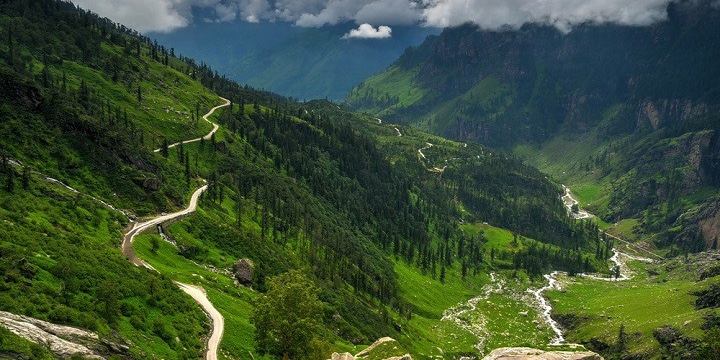

HIMALAYA CROSSING
Between Keylong and the hidden valleys of Zanskar lies the Great Himalayan Range. Crossing this tallest mountain range in the world means following a largely unpaved jeep trail along steep boulder-strewn slopes, through small rivers and snowfields and of course some very spectacular mountain scenery. The highest point is reached at Shingo La (5090m), a snow-covered pass surrounded by glaciated peaks.
After that, you descend into a wide valley where yaks, marmots and Ladakhi bluesheep graze, at the foot the remarkable Gumburanjon mountain. The landscape couldn’t be more different from the forest-clad mountains of Kullu Valley. Here, the mountains are barren, due to the extreme dry climate, and extremely colorful. ‘Zanskar’ means the land of the copper-red mountains.
Hidden monasteries of Zanskar
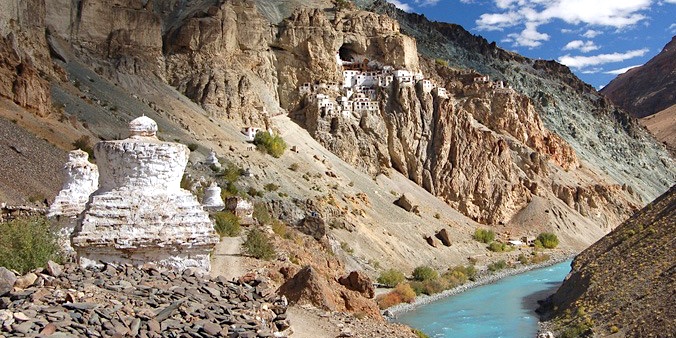
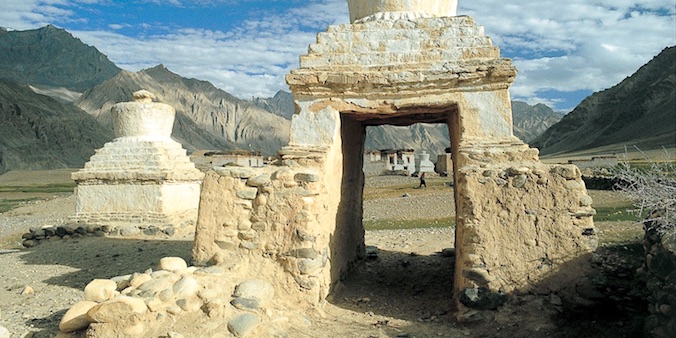
ZANSKAR
LAMAYURU & ALCHI GOMPA

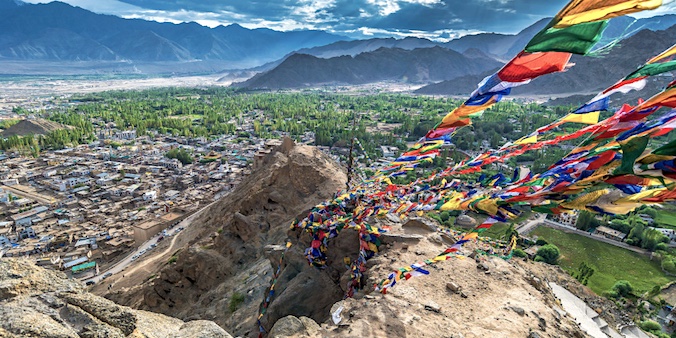
LEH
CARAVAN ROADS OF LADAKH
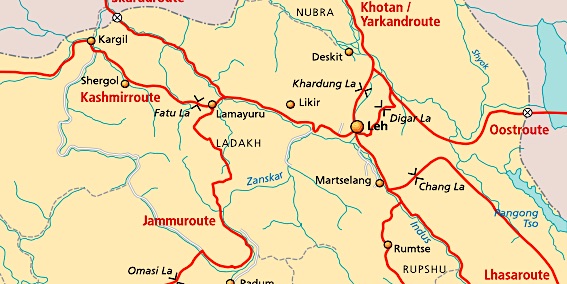

Khardong La
NUBRA VALLEY
